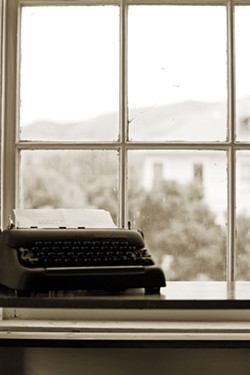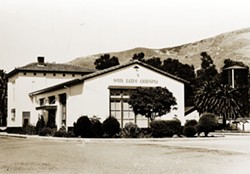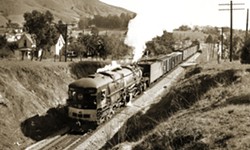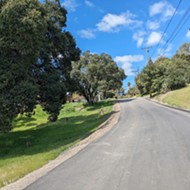[{
"name": "Newsletter Promo",
"id": "NewsletterPromo",
"class": "inlineCenter",
"insertPoint": "4",
"component": "15264767",
"requiredCountToDisplay": "0"
},{
"name": "Ad - Medium Rectangle CC01 - 300x250",
"id": "AdMediumRectangleCC01300x250",
"class": "inlineCenter",
"insertPoint": "8",
"component": "2963441",
"requiredCountToDisplay": "12"
},{
"name": "Ad - Medium Rectangle LC01 - 300x250",
"id": "AdMediumRectangleCC01300x250",
"class": "inlineCenter",
"insertPoint": "18",
"component": "2963441",
"requiredCountToDisplay": "22"
},{
"name": "Ad - Medium Rectangle LC09 - 300x250",
"id": "AdMediumRectangleLC09300x250",
"class": "inlineCenter",
"insertPoint": "28",
"component": "3252660",
"requiredCountToDisplay": "32"
}]
There is almost no historical record of Jack Kerouac’s stay in San Luis Obispo. The San Luis Obispo Historical Society has no photos of him or his neighborhood haunts. And there certainly is no plaque in front of his former home to say “this is where Jack Kerouac slept.” It’s as if he didn’t exist here in 1953, at what was likely the peak of his creative genius. But the signs pointing to a San Luis Obispo life—however brief—are all there in his writing: a first-page reference to SLO in The Dharma Bums, shutter-speed descriptions of the city from his Book of Sketches, and his playful notebook, called the Book of Daydreams—San Luis Obispo.
It’s enough that, fifty years later, one could begin to put the pieces back together; his neighborhood, in character and architecture, is still there. The creek where Kerouac used to meditate still flows through town, as does the stream of hobos, who still live along the waterway, as he described them. Though the names gracing the facades have been painted over with the names of new tenants, it’s still Kerouac’s Railroad District.
In the spring of 1953 Kerouac made his way to sleepy San Luis Obispo to work for the Southern Pacific railroad, which had, in March that year, made the switch from steam engines to diesel. Joseph Stalin had died in March, but the Red Threat continued to menace the Central Coast, via the Telegram Tribune’s front page, for months afterward. Among the most debated issues in the county was whether or not to add fluoride to the public water supply to combat tooth decay. Several community groups sprang up on both sides of the issue, including the Citizens Committee Against Fluoridation, the Citizens Committee for Fluoridation, and the Los Altos Republican Women Against Fluoridation.
Kerouac moved to California and would work as a brakeman, assisting the train conductor on freight runs over the grade between SLO and Santa Margarita. It wasn’t a glamorous existence, and Kerouac would complain in letters that he couldn’t smoke “the holy weed” of marijuana while he worked. But in the beginning California and the Central Coast seemed like heaven to him. By 1953, Kerouac had completed several trips around the country and to Mexico; the memories of those trips alone was enough to provide material for several books. Kerouac was exhausted.
“I love California more and more,” Kerouac wrote of SLO in his notebook. “If everyone loved it as I do, dear abandoned Jack, they’d all be here—”
There were about 16,000 people living in the city then, most of them employed or engaged in agricultural pursuits, primarily ranching. Kerouac was able to find a room to sleep near his work for just $6 a week—cheap even by 1953 standards. From his post, a stone’s throw from the railroad, the nights were hushed. Kerouac wrote to his mother of the quiet bliss; he wrote of falling asleep to the sound of crickets.
The house was a two-story rectangle occupying a corner lot on Santa Barbara Street. Its name, either the Colonial Hotel or the Hotel Colonial, was painted across the front, beneath a set of tall windows, and windows lined each side of the house, bringing in the sun. He didn’t have a private entrance, or even a bath in his room, but there was a sink and a stove where he would cook eggs, toast, steak, and coffee. The wood floors of the house slanted so that a marble let loose on the northeast side would role to the opposite corner if there were no walls to stop it. The house is still there, still slanted atop the old foundation.
Back then, the place was run by a woman named Amelia Neustrom. She was the daughter of Swedish immigrants who had settled in Illinois. Amelia had been in SLO for 16 years and in 1953, at 70 years old, her health was deteriorating. Her husband Emil ran a gas station nearby, and took over management of the hotel after she died that year. Kerouac was one of probably a dozen boarders living in the house at any time. He wasn’t famous yet, but most of his major works, excluding Big Sur and The Dharma Bums, were completed.
Kerouac had recently rejected an offer to publish his novel Doctor Sax, because he didn’t want it to be torn apart by editors, and while he forewent having his work published, William Burroughs, another famous Beat writer, got a deal for his autobiographical novel, Junky.
The Beats as a group and movement were gaining notoriety, and Kerouac was trying to distance himself from them. His second wife was also eager to find him, to prove the paternity of her daughter. Kerouac, however, wasn’t trying to be found.
“’53 is a great year for Kerouac in the sense that he was at his peak in creative energy and youth,” Professor Robert Inchausti opined. Inchausti teaches a class on the Beats—from the word beatific—at Cal Poly.
Between 1951 and March 1953, according to his notes, Kerouac wrote four novels, including On The Road, Visions of Cody, Doctor Sax—one of his most imaginative books—and Maggie Cassidy, which he completed just weeks before moving to San Luis Obispo. In the spring he sat in his room upstairs at the Colonial and pondered his next book, his next move. He focused often on the virtues of poverty and labor, expressed desire to live like a fellah—a farmer or rural person living off the land in the Middle Eastern tradition, as opposed to a nomad, the life with which he eventually became synonymous.
Who was Jack Kerouac?
Kerouac’s place in literary history is undecided. He brought a new style to the literary landscape, often called “Bop Spontaneous prose.” It’s an approach meant to convey the truth in a particular moment, to hit emotional chords the way Bop Jazz did in the ’40s. When he wrote, it was of his own and his close friends’ experiences. Those experiences included lots of sex, drugs, train-hopping, and car-stealing. It was a radically different approach to the American novel, and it worked for Kerouac.
On the Road
was supposedly written in just three weeks, on one continuous scroll. It was his first novel published in the trademark style, and has been translated into 33 languages since then, but still has not been universally embraced.
“As far as his literary impact,” Inchausti said, “it’s probably been a mixed bag because people try to imitate his style without his sympathy for the world. He gets confused with the imitators.”
The author Truman Capote famously dismissed his work, and his marathon style of writing, saying of On the Road, “That’s not writing, that’s typing.” And after his fame was established, critics blamed him for every social ill beginning with the degradation of the English language and ending with inspiring juvenile delinquency.
Kerouac rejected the stability of four walls and the security of a regular income at a time when most Americans were reveling in post-war consumer bliss. His exploits with Neal Cassady in the late ’40s and early ’50s, fictionalized, glamorized, and published as On the Road in 1957, inspired a generation of kids in the ’60s to do the same.
“Kerouac’s impact on the American psyche is probably immeasurable,” Inchausti said. “The counter culture movement couldn’t have existed without him. …”
Kerouac wrote Back East to his mother Gabrielle in April, describing his “great little hotel room,” his life, and their future together in SLO. He wrote that he had steady work on the Southern Pacific. He would have $80 by the end of the month and he hoped to save $2,000 by December. He hoped to then bring Gabrielle out to California. He wanted to buy a trailer that was advertised in the local paper.
“The best idea I think will be for us to start in a trailer,” he wrote his mother, “for about a year, till we get a start … One thing sure, California is beautiful and ideal and will be our home …”
In almost the same breath, in his writing he described San Luis Obispo as being akin to a “sanitarium.” It doesn’t take much of a leap to understand the source of that image: from Kerouac’s window, across a small park, there is the shell of an old state-run sanitarium. It’s a beautiful guesthouse now, with the word “sanitarium” printed above the porch.
During this time he was experimenting with what he called word sketches—brief descriptions of things he saw, written in fragments, instead of complete thoughts. The idea was to sketch an image with words in the same way an artist could sketch the feeling and basic structure, then keep adding details to create a whole image. Word sketches, in turn, were just a piece of his total writing philosophy.
While Kerouac seemed to be between the feverish writing spurts that would produce two novels that year, his pen was still moving and he wrote little notes to express what he was experiencing in SLO.
Behind big engine 3669
In the bright day of
San Luis Obispo the
mtns. of hope rise
up, treed, green, sweet
—a rippling palm
behind the pot Steams—the young firemen of
Calif. waiting to
make the hill up to
the bleakmouth panorama plateau of
Margarita where
stars of the night are holy—
The sketches explored his belief that one could express the truth in a situation by writing down the moment as an unbroken, unedited thought. He expounded on the practice:
Unbroken word sketches
of the subconscious pictures
of sections of the
memory life of an
imbecile genius resting
in the madhouse of his
mind—the word
flow must not be disturbed,
or picture forgotten for
words’ sakes, nor the
pictures stretched beyond
their bookmovie strength
except parenthetically.
And:
Work from your own side of literature
& room fetish, not “publishing’s”—
It’s the Holy Memory
It’s the dinihowi of
Memory
It’s fit for dunes &
desert huts & railroad
hotels
Let them pick the story
out of the house of your
words, floor by floor, room
by room
occasionally to meditate.
In The Dharma Bums, Kerouac describes his meeting with a spiritual hobo on the train between Santa Barbara and SLO. Dharma wasn’t written until many years after Kerouac stayed in SLO, but already he was seeking out the company of bums. Kerouac wrote a lot in 1953 about living simply and herding goats, but conceded, “Most of these observations arise from the fact that I can’t get a woman anyhow—‘too bashful,’ too ‘scowling’—”
He wrote increasingly of settling on a simple life, of “celibacy”—which meant to him giving up trivial things like gum chewing, not sex. The two life paths before him, as he saw it, were the Fellaheen life of simplicity, or the American life of decadence. If Kerouac was following his own dharma, the following passage explains a bit about what he eventually chose, and why writing exactly what he felt in the moment was the only truth.
1953
Fellaheen vs. America
Be decadent, work in US &
Have a Fellaheen Homestead too
All I want
Is love when I want it
Rest when I want it
Food when I want it
Drink when I want it
Drugs when I want it
The rest is bullshit
I am now going out
to meditate in the
grass of San Luis Creek
& Talk to hobos &
Get some sun & worry
Where my soul is going
& What to do & why
as ever & ever shit
From his window, Kerouac could watch the young girls walking home from school, and he noted the way the cement sparkled, and the way the railroad tracks glistened with dew in the mornings. Despite what he told his mother about living in SLO, by May Kerouac was restless again.
He hopped a ship out of San Francisco, hopped off at New Orleans and got inspired again. In the fall he wrote The Subterraneans.
The San Luis Obispo house Kerouac briefly called home was neglected for a long time after that. Even the weeds died and it was just a box on a dirt corner. With mattresses on the floor and holes through walls, it became a true flophouse for the very generation Kerouac inspired, and that group renamed the house for the new social/political Establishment.
For a long time in the Railroad District, a lot of people have claimed to live in the house where Kerouac may or may have not stayed. The rumor, it is said, stemmed from a line in one of Kerouac’s books, that he spent the night in a “flophouse” that was “a stone’s throw from the railroad station.” All told, those words have been uttered as proof that Kerouac stayed in a half-dozen houses. A guy name Lee, who used to live above the Alano Club, next door to Café Roma, said it had to be the Alano Club, because that was the only flophouse that was literally a stone’s throw. The Park Hotel, before its resurrection in the ’80s, was as cheap and seedy as it gets in SLO—a very likely candidate. For years it all seemed ambiguous whether he laid his head down for just one night in SLO or actually began to take root in the neighborhood; even the year was seriously debated.
SLO historian Dan Krieger said he had heard a version of the Kerouac rumor before and even knew of a couple of students and one reporter who tried to nail it to the house called the Establishment, but Krieger said he never heard anyone confirm it.
Confirmation came, in the end, from Kerouac’s words themselves. So much of Kerouac’s previously unpublished writing, including letters, the sketches, and personal writing, has been published in the last ten years that the task of tracking his movement has become easier. Kerouac was a prolific letter writer and he sent off a few with a San Luis Obispo return address: 103 Santa Barbara Street, the Colonial Hotel.
The address, like the hotel, doesn’t exist anymore, since the street was moved and the building has changed owners several times. It’s 1703 Santa Barbara Street now, the Establishment. There is a family of sorts living there, and whatever the house was, they say it has evolved into something more.
The neighborhood, however, relatively stable for decades, will soon be “revitalized,” with a modern condo complex proposed to be built across the street and an updated Railroad Square being built to proudly welcome visitors into the heart of the city. The neighborhood could be prosperous again, as it was when commerce from the train dominated the area, but with these changes it’s hard to know if Kerouac’s window view of the Santa Lucians will remain intact.
Staff Writer Kylie Mendonca can be reached at [email protected]. She thanks the SLO Historical Society, especially Pete Kelley, and the SLO Genealogical Society, for their help with this article.
Latest in News
Readers also liked…
-

Coast Unified teachers upset over new position's salary and qualifications
Oct 20, 2022 -

SLO police identify alleged driver who hit and killed couple
Dec 22, 2022 -

When the levee breaks: Oceano residents, county officials walk a tightrope of regulations to manage Arroyo Grande Creek, which some say led to the levee's failure in January
May 18, 2023











